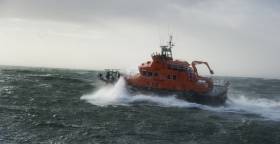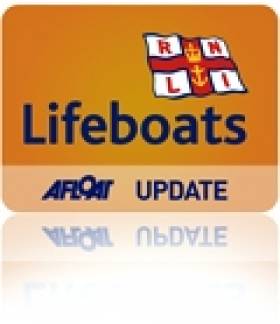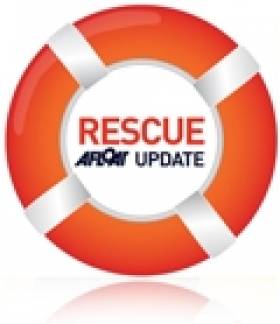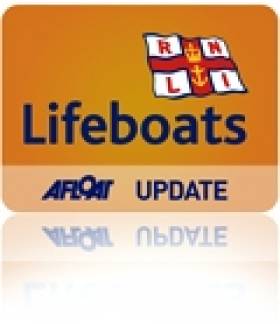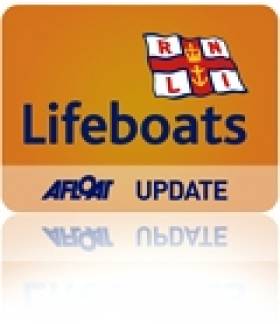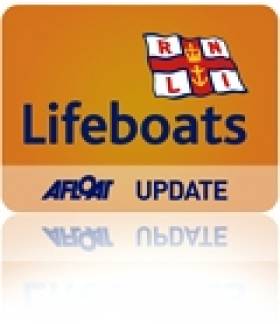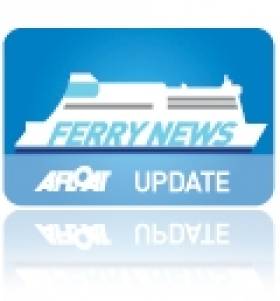Displaying items by tag: Rosslare
Two fishermen have been brought to safety this afternoon by the RNLI after they got into difficulty off the Wexford coast.
Wexford RNLI was requested to launch their inshore lifeboat at 12.08pm following a report that a fishing vessel with two people on board was experiencing mechanical difficulty a mile and a half south east of Blackwater Head.
The lifeboat helmed by Frank O’Brien launched and made its way to the scene. Wexford RNLI then requested the assistance of Rosslare Harbour RNLI due to the location of the fishing vessel some 12 miles north of Rosslare Harbour. It was the fourth call out in a week for the volunteer lifeboat crew from Rosslare.
The all-weather lifeboat under Coxswain Eamonn O’Rourke and with eight volunteer crew members on board launched at 12.29pm and made its way to the scene.
Weather conditions at the time were described as overcast but good. The men had been razor fishing when their boat got caught in lobster pots.
Once on scene, the lifeboat crew observed that no one was in immediate danger and began to work with the fishermen to establish a towline.
The vessel was then taken under tow and brought to the bar of Wexford escorted all the time by Wexford RNLI’s inshore lifeboat. Once there, Wexford RNLI took over and brought the vessel to shore at 4pm with the assistance of another fishing vessel which was in the area at the time. Having only finished a routine exercise when they were requested to launch at midday, this meant the volunteers from Wexford had spent some six hours at sea.
Meanwhile, yesterday (Saturday 12 March) Rosslare Harbour RNLI’s all-weather lifeboat under Coxswain Keith Miller launched in thick fog at 7am after a fishing boat with three people on board was reported to have lost its rudder just off Rosslare. The lifeboat once on scene took the boat under tow and brought it to Blackrock where it was met by Kilmore Quay RNLI’s all-weather lifeboat which towed it into Kilmore Quay.
Meanwhile, at 6.30am on Thursday, the lifeboat launched under Coxswain Eamonn O’Rourke to go the assistance of a fishing boat which had broke from her moorings overnight and blew ashore due to a change in the weather conditions. On this occasion the lifeboat crew established a tow before the vessel was brought alongside the fishermen’s wall in the harbour.
Speaking following today’s call out, David Maloney, Rosslare Harbour RNLI Lifeboat Operations Manager said: ‘The fishermen did the right thing this afternoon and raised the alarm when they began to experience some difficulty. Our volunteers both from Rosslare Harbour and Wexford responded rapidly and worked well together to bring the fishermen safely to shore. It has been a busy week for our volunteers but they are always ready and delighted to help anyone in need at sea.’
Three Men & A Dog Rescued By Coastguard
#Coastguard - Waterford's coastguard helicopter went to the aid of three men and a dog whose boat was grounded on a sandbank near Rosslare Strand yesterday evening (Wednesday 23 December).
As BreakingNews.ie reports, coastguard units from Rosslare and Carnsore joined Rescue 117 in the operation, with the helicopter airlifting the men and their dog to safety.
Elsewhere, the Sligo-based Irish Coast Guard chopper Rescue 118 flew nine stranded islanders home to Tory Island yesterday, according to Independent.ie.
The coastguard stepped in to fly the nine passengers along with post and other supplies to the island off the Donegal mainland after ferry services were disrupted by Storm Eva.
TheJournal.ie has photos of the serious swells the storm brought to the North West coast in particular.
100 Years Since Rosslare Lifeboat's Daring Rescues In Hallowe'en Gales
#RNLI - Today – 1 November 2015 – marks 100 years since the end one of the most daring days in the history of Rosslare RNLI, when the station's volunteers rescued six crews within a single 24-hour period.
With the Wexford coast being assailed by easterly Force 7 gales on Hallowe'en that climbed to Force 10 overnight, and vessels in Rosslare Harbour dragging their anchors towards danger, the lifeboat crew rowed right into the thick of it - plucking crews from schooners and other vessels that would soon after be bound for the seabed.
The RNLI has much more on the story HERE.
Rosslare Small Boats Festival Celebrates 30th Birthday
The Irish boat ‘Screaming Reels’ has won the Rosslare Small Boats Festival for the fifth year in a row. The boat, from Rosie’s Sea Angling Club in Cork, beat 36 other boats from across Britain and Ireland and caught 29 species of fish at the Festival which took place from 6th to 12th September.
The event, sponsored by Inland Fisheries Ireland, DAIWA, Lowrance, Sea Angler magazine, Fáilte Ireland, Wexford County Council, IPB Insurance and Mannings, is now in its 30th year and this year attracted more than 115 anglers from Wales, Scotland, Isle of Wight, Ireland and many parts of England including Southport, Liverpool and Cornwall.
Having started in 1985 with only five boats fishing, the standard of the fishing and variety of species available in the rich waters off the south east coast of Ireland, coupled with a very high standard from the competitors, has meant that this competition has since grown every year. With 38 different species of fish recorded during the competition, the quality and standard of fishing in Wexford creates considerable revenue for tourist angling and the local economy, contributing more than €300,000 per annum and making the event the most prestigious small boat fishing festival in Europe.
The competition was fierce with boats recording up to 20 species on the first day and 17 on the days thereafter. This continued right throughout the week with many boats neck and neck, and one third of competitors catching 25 different types of fish species. Weather conditions were very good for the competition with settled conditions and light winds. Boats could be launched from Kilmore Quay every day enabling them to target all species.
The Irish boat ‘Screaming Reels’ proved their mettle once again taking first place with 29 species for 25.81kgs. This crew consisting of Martyn Rayner (skipper) Seirt Shults and Neville Murphy from Rosie’s Sea Angling Club in Cork have continued to raise the bar of the Rosslare small boats fishing competition. Second place went to the boat ‘Sandstorm’ (Nathan James and Ian Jenkins) from Porthcawl in Wales with 27 species for 21.29 kilos. In third place was ‘Dunlin’ (Andy Beresford, Lewis Radcliffe, Jonathan Roberts) from Southport boat angling club with 27 species for 14.02kgs.
For the first time Inland Fisheries Ireland introduced a marine fish tank for the purpose of displaying some of the fish species that were caught during the competition. This idea proved to be a great success, with anglers and staff from Inland Fisheries Ireland on hand to educate the public about the fish species on offer from Kilmore Quay.
People were able to see for the first time marine fish such as thornback ray, various wrasses, gurnards, bull huss and bass which were kept in the fish tank and released back into the sea alive. The educational benefits of the tank and practising catch and release for marine species are hugely beneficial in terms of conservation and creating public awareness of our sea fisheries resource. Two boats ‘Cod n Bass’ and Seeker’, both from Southport in the UK, won the prize for returning the most fish alive during the competition.
There were 3 specimen smooth-hounds caught, the largest of which was 4.3kg caught by John Belger on board the boat ‘Firefly’ and he was awarded for specimen of the week. The heaviest round fish was a bull huss of 5.62kgs caught by Martyn Rayner aboard the Irish boat ‘Screaming Reels’ and he was also awarded a perpetual trophy sponsored by Inland Fisheries Ireland for the biggest fish caught of the week. The heaviest flat fish was a flounder of 0.92 kilos caught by Seirt Shults from ‘Screaming Reels’. Ryan Andrews aged 17, from Wales aboard the boat ‘Provider’, won the best juvenile of the competition with 16 species for 12.92kgs.
‘Redmond’s The Bay’ in Rosslare Strand hosted the prize giving ceremony and a presentation was made to the Irish Heart Foundation for over €3,500 which was raised by anglers. The RNLI also received a generous donation. The total prize fund for the competition was €20,000 including fishing equipment and substantial monetary prizes and engraved trophies.
Suzanne Campion, Director of Business Development, Inland Fisheries Ireland presented the prizes and said: “I am delighted to be at the Rosslare Small Boats Festival again and to see so many dedicated anglers here to celebrate the 30th year of this fantastic event.
“I would like to congratulate all anglers for participating in this competition, I know that some have been coming here for many years. The people of Wexford welcome all visitors and we appreciate their continued support of this festival. The Festival generates over €300,000 for the local economy, bringing jobs and employment. I would particularly like to thank John Belger and his committee in the UK and Ireland for their hard work in organising this competition.”
Next year’s event will take place from the 10th to 17th September 2016, and Inland Fisheries Ireland is calling all small boat anglers to take part in next year’s Festival.
Further information is available from Ms. Josie Mahon, Inland Fisheries Ireland, Tel: 01 8842 600
Wexford Lifeboats Assist Two After Yacht Breakdown
#RNLI - Volunteer lifeboat crew from Wexford and Rosslare Harbour RNLI launched on Sunday (14 June) to go to the assistance of two people onboard a 37ft yacht which got into difficulty off Wexford’s east coast.
Wexford RNLI launched their inshore lifeboat first at 4.30pm following reports that a yacht had suffered engine failure two miles south west of Raven’s Point. They then requested the assistance of their colleagues at Rosslare Harbour RNLI who subsequently launched their all-weather lifeboat.
Weather conditions at the time were described as good with a Force 5-6 northerly wind blowing. The sea was calm and there was good visibility.
The Wexford lifeboat, helmed by Lorraine Galvin and with crew members Simon Gulliver and Martin Conway onboard, arrived on scene at 5pm. Gulliver, who is also Wexford RNLI’s station mechanic, boarded the yacht and assessed the situation.
After inspection, Gulliver was able to get the fuel system working again and ran the boat for 10 minutes to ensure the vessel was operating smoothly. Rosslare Harbour RNLI stood by meanwhile, ready to assist if required. Following the checks, the yacht was able to continue on its journey.
Speaking following the callout, Galvin said: "We were delighted to be able to assist the two people who got into difficulty on their yacht today.
"Simon’s skills as mechanic paid off as he successfully managed to get the yacht back underway and in doing so avoided a lengthy tow back to shore."
Man Overboard From Rosslare Ferry, Bray Head Climber In Fall
#Rescue - RTÉ News reports on two separate coastal rescues off Rosslare and Bray Head yesterday (Sunday 12 October).
One man fell overboard from Irish Ferries' Oscar Wilde ferry sailing out of Rosslare Europort about an hour after leaving port.
The passenger was recovered from the water and returned to Rosslare, from where he was taken to Wexford General Hospital.
Meanwhile, earlier in the day another man was hospitalised with head and back injuries after a fall while climbing Bray Head with friends.
RTÉ News has more on the story HERE.
Rosslare Lifeboat Tows Stranded Cruiser To Safety
#RNLI - Rosslare Harbour RNLI towed to safety an 8-metre motor cruiser that was stranded off the Wexford coast with three on board on Thursday evening (18 September).
The volunteer crew launched their all-weather lifeboat at 9pm to go to the assistance of the cruiser, which developed fuel problems some 16 miles north east of Rosslare Harbour.
The three crew on board the cruiser contacted the Irish Coast Guard for assistance. They were in no immediate danger.
Sea conditions were described by the lifeboat coxswain as rough, with a north-easterly wind blowing Force 4-5.
Speaking after the callout, Rosslare Harbour RNLI volunteer lifeboat press officer Jamie Ryan said: "The lifeboat coxswain and crew showed professionalism in establishing a tow in what were described as challenging conditions."
#RNLI - Rosslare RNLI was called out twice yesterday afternoon (Friday 22 August) to help two separate boats with ropes wrapped around their propellers.
In the space of two hours, both boats – a RIB with two people on board off Carna Pier and a motor cruiser with two on board near Waterford Harbour – were freed by the volunteer lifeboat crew.
The double callout also came on the last day for retiring lifeboat operations manager Michael Doyle.
"Two callouts in one afternoon is a fitting way to say goodbye," said Rosslare RNLI volunteer lifeboat press officer Jamie Ryan.
"Thankfully both call outs were to vessels that had their propellers fouled and no lives were in danger. The lifeboat is there to help anyone in trouble at sea and we were happy to provide assistance in these two cases."
Elsewhere on the east coast, Wicklow RNLI's all-weather lifeboat launched at 4am yesterday morning to the aid a yacht in difficulty eight miles north of Wicklow Harbour.
The yacht was on passage to Greystones when the propeller became fouled in ropes and was unable to make any headway.
"We located the yacht with four people one mile south-east of Greystones Harbour," said coxswain Nick Keogh. "Two lifeboat crew were transferred onto the yacht to assess the situation and they managed to clear the rope obstructing the propeller.
"With the propeller free the yacht was able to make her way into Greystones under its own power."
Arranmore Lifeboat Rescues Injured Fisherman
#RNLI - The crew of the Arranmore RNLI lifeboat were called on Wednesday afternoon 25 June to assist a fisherman involved in an accident on board a 12-meter fishing boat some 12 miles northwest of Tory Island.
Malin Head also dispatched the Irish Coast Guard helicopter from Sligo to assist in the evacuation of the injured fisherman in his mid-40s.
Anton Kavanagh, coxswain of the Arranmore lifeboat, said the transfer of the casualty went smoothly as the weather was good and the lifeboat had no problems manoeuvring alongside the fishing boat.
The casualty was transferred from his boat to the care of the lifeboat crew and taken to Burtonport, where he was transferred to Letterkenny Hospital by ambulance.
This is the fourth time in five days that the Arranmore lifeboat has been called out to render assistance. Two of the calls were medical evacuations from Arranmore who were transferred to Letterkenny Hospital by ambulance.
At the weekend, the lifeboat was called to search for a missing swimmer off Portnoo. Fortunately the swimmer was located by coastguard helicopter and the lifeboat returned to Arranmore.
Elsewhere, Rosslare Harbour's lifeboat and its volunteer crew launched at 7.30pm yesterday evening (26 June) to a reported sighting of two people stranded on a rock surrounded by water.
The alarm was raised by a concerned member of the public. Arriving at the scene within 15 minutes of launch, the lifeboat's daughter craft was deployed and it was soon clear that the two people were fishermen in no immediate danger.
Rosslare Harbour RNLI lifeboat press officer Jamie Ryan said: "The person who raised the alarm did the right thing. It is always better to call out the lifeboat and let them check on a person or situation of concern then to ignore it and risk a serious incident.
"The lifeboat crew are volunteers and never mind being called out to check on a situation."
First Ever Ferry Service from Ireland to Spain Announced
#ferry – Minister for Transport, Tourism & Sport Leo Varadkar has welcomed the second significant announcement of a new ferry route into Ireland in a matter of weeks, after LD Ferries confirmed a weekly service from western France and northern Spain.
The LD Ferries service will connect Rosslare with St Nazaire on the west coast of France, and with Gijón in northern Spain.
"This is a very welcome announcement and provides a valuable new landbridge from France and Spain into Ireland. It's the first service of its kind to Ireland, and it's great news for our tourism industry.
"This is the second positive announcement of a new ferry service in a matter of weeks. Last November a new route from Cherbourg to Dublin was announced.
"We are already well serviced in terms of air access, but this new route will help us to grow ferry tourism into Ireland. Driving holidays encourage visitors to spend longer in Ireland and to explore more of the country. It's very good news as we build on the success of The Gathering next year."
Port of Cork adds:
New Ferry Service from Cork to Santander Set to Increase Tourism and Freight in Munster
The Port of Cork Company today welcomed the announcement of a new route into Northern Spain from Cork which is due to commence at the end of April 2018. The service which will make two return sailings a week from Port of Cork to Port of Santander will be operated by Brittany Ferries and will include a weekly return sailing from Cork to Roscoff also.
A new RoPax ship called ‘Connemara’ will be chartered to serve the route which will add much needed capacity to Brittany Ferries existing line to France from Cork. The ship is currently operating on routes between Italy and Greece and will carry around 500 passengers with space for 195 cars. The Port of Cork and Brittany Ferries would expect a fifty-fifty split between passengers and freight carried.
Port of Cork’s Commercial Manager Captain Michael McCarthy said, “The Port of Cork wholeheartedly welcomes a service we have been trying as a port to establish for some time now. We are delighted that our long term customer, Brittany Ferries, has committed to this new service which will see an increase in tourism and freight. The option for freight carriers to bypass the UK land bridge will be seen as very attractive, as Brexit uncertainty continues. We have no doubt that both exporters and importers will make this a viable service.’
At present, there is a range of opinion about possible ‘hard’ and ‘soft’ UK Brexit scenarios, the timing and likely effects. For example, a ‘hard’ border (at ports and across Irish Sea) would mean Customs controls for ports serving the UK, increasing the need for this direct service between Ireland and Spain and an opportunity for Cork as a new ‘centre of gravity’.
The Port of Cork hinterland is the key primary agriculture and Food & Drink output region in the country. The vast majority of the goods imported and exported through Cork are consumables in the perishables arena such as wines, spirits, dairy, water and a wide range of other supermarket products. Freight customers will like this route because the Port of Cork can load and unload quickly thereby enabling customers to get their produce to market quicker, than if they travel through East Coast ports.
This new route to Northern Spain and France will greatly reduce the amount of road miles and therefore providing a lower cost door to door option for shippers. This will provide substantial carbon (CO2) cost saving that is becoming increasingly relevant to companies that are seeking to exhibit their ‘green’ credentials
The new service from Brittany Ferries is expected to be on sale by the end of January.


























